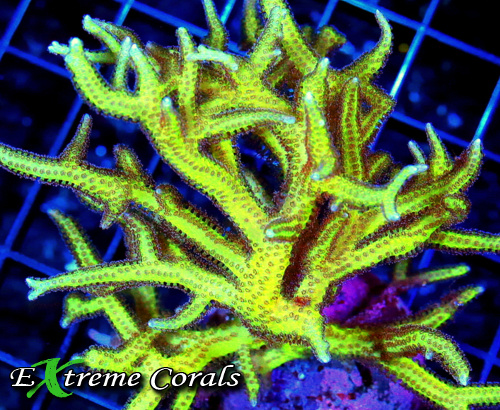Extreme Corals News and Updates
How to Care for Seriatopora in a Reef Tank
Find out how to properly care for your new Seriatopora Coral with this "how-to" guide on the requirements for healthy Seriatopora Coral from the #1 place to buy corals online!
Read along to find out the Lighting, Water Flow, Feeding, Placement & more when it comes to the care of your new Seriatopora Coral
by scott Shiles • March 30, 2023
Seriatopora, commonly known as bird's nest coral, stands out among stony corals for its intricate growth pattern and
vibrant colors. Found predominantly in the Indo-Pacific region, including popular diving spots like the Great Barrier
Reef, Fiji, and the Red Sea, these corals have become prized possessions for hobbyists due to their aesthetic appeal and
relative ease of care.
Bird's nest corals, known for their unique branching structure reminiscent of a bird's nest, add a touch of natural
artistry to any reef tank. Their branches form an intricate network, providing refuge for small marine creatures while
creating a visually stunning centerpiece. Their vibrant colors, ranging from vivid blues and greens to striking pinks
and purples, further enhance their allure, captivating the attention of both novice and experienced reef keepers alike.
One of the remarkable aspects of bird's nest corals is their adaptability to different environments within the reef.
Whether in areas with strong wave action or tranquil lagoons, these corals exhibit varying growth forms, adjusting to
the prevailing conditions. In environments with higher light intensity and water movement, such as shallow upper reef
slopes, species like Seriatopora caliendrum thrive with blunter branch tips, reflecting their ability to adapt to
specific habitats.

Maintaining optimal conditions for bird's nest corals is essential for their health and vitality. Hobbyists must ensure
stable water parameters, including temperature (maintained between 75-82°F or 24-28°C), pH levels (ranging from
8.1-8.4), and specific gravity (between 1.023-1.025). Additionally, monitoring and controlling ammonia, nitrite, and
nitrate levels at 0 ppm, along with phosphate levels at 0.03 ppm or lower, are critical for their well-being. The use of
a high-quality protein skimmer aids in maintaining water quality, promoting a thriving environment for these corals.
Lighting
Proper lighting is another key factor in bird's nest coral care. Moderate to high lighting conditions, preferably
provided by LED lights with a PAR output of 250-350 µmol/m2/s, support photosynthesis and overall coral health. A
photoperiod of 8-10 hours per day mimics natural lighting cycles, contributing to the coral's biological rhythms and
growth patterns.
Water Flow
Water flow is equally important for bird's nest corals, facilitating nutrient uptake and waste removal. Moderate to high
water flow, achieved through a turnover rate of 10-20 times the aquarium volume per hour, ensures that these corals
receive adequate oxygenation and nutrient exchange. Wavemakers or powerheads can be utilized to create the necessary
water movement within the tank.
Feeding
While bird's nest corals primarily rely on photosynthesis for nutrition, supplemental feedings of planktonic food, such
as phytoplankton and zooplankton, can benefit their overall health. Target feeding once or twice a week using a pipette
or feeding tool helps ensure that these corals receive essential nutrients to support growth and vitality.
Placement
Placement to maintain the health and vitality of Seriatopora, commonly known as bird's nest coral, it is crucial to
consider its placement within the aquarium. within the aquarium. Bird's nest corals should be positioned in areas of
moderate to high water flow and under appropriate lighting conditions to support their growth and well-being.
Placement within the aquarium should allow for sufficient water movement around the coral, ensuring effective nutrient
exchange and waste removal. Placing bird's nest corals in areas with moderate to high flow, achieved through the
strategic positioning of wavemakers or powerheads, helps mimic their natural habitat conditions and promotes optimal
health.
Additionally, adequate lighting is essential for the photosynthetic processes vital to bird's nest coral survival.
Positioning these corals in areas with moderate to high lighting intensity, provided by LED lights with a PAR output of
250-350 µmol/m2/s, ensures sufficient light penetration for photosynthesis and supports overall coral health.
Propagation
Propagation through fragging offers enthusiasts the opportunity to expand their coral collection and contribute to
conservation efforts within the hobby. Fragging, however, should only be attempted by experienced hobbyists to minimize
stress and potential harm to the coral. By adhering to proper fragging techniques, hobbyists can propagate bird's nest
corals responsibly, fostering their sustainability within the aquarium trade.
Disease Prevention
Disease prevention is paramount in maintaining the health and longevity of bird's nest corals. Quarantining new
additions to the aquarium, regular water changes, and maintaining stable water parameters are essential practices to
mitigate the risk of disease outbreaks. By implementing these preventive measures, hobbyists can safeguard their coral
populations and preserve the beauty of their reef ecosystems.
In conclusion, bird's nest corals, with their captivating branching structure and vibrant colors, are prized additions
to reef aquariums. By understanding their natural habitat requirements and providing optimal care, hobbyists can create
thriving environments that showcase the beauty and resilience of these remarkable corals. With proper maintenance and
attention to detail, bird's nest corals will flourish, enriching the aesthetic appeal and biodiversity of reef tanks for
years to come.
overall rating:
my rating:
log in to rate
Please log in to leave a comment.
For more information visit: additional resources

